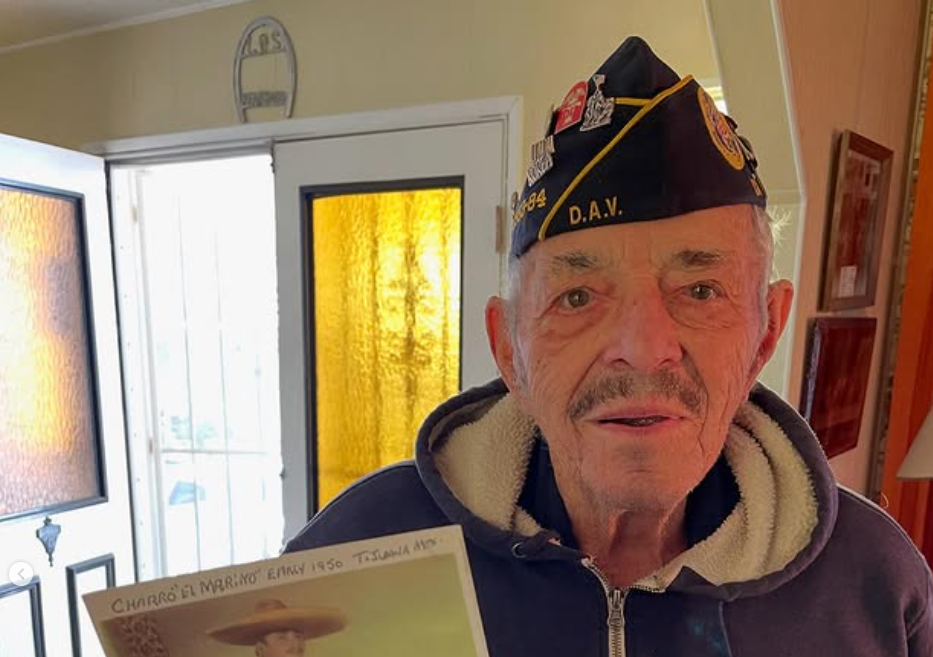Juan Montaño
“Charro EL Marino"
Higgins boat coxswain
USS Bell Grove (LSD-2)
One Tough Hombre
I first met Juan at the 79th Iwo Jima Anniversary in DC last year. I quickly learned that at age 97, Juan decided to attend on a whim, putting on his uniform (that still fits), driving himself to the airport, and hopping on a flight the day of the reunion.
Juan Manuel Montano was born in Detroit, Michigan, on June 27th, 1926. Juan recalls the depression as being “really tough, really bad.” He began working at eight, shoveling snow from sidewalks and doing other things to make ends meet. Later, Juan would go to work at Cadllaic, where he worked the graveyard shift, beginning his shift at 10 pm. At 15, Juan left school and ran away from home. He then joined an “uncle” on his ranch in Michigan, UP, and began to work on the farm.
Juan learned of Pearl Harbor and knew something big was coming. Initially, he wanted to join the Marines but was afraid he would get caught for being underage. Later, he had his dad sign his papers, joining the Navy at 17, disqualified from the Marines for being flat-footed.
He attended boot camp at Great Lakes and was later assigned to the USS Bell Grove (LSD-2) after a week or two of leave. The Bell Grove soon left for Pearl Harbor, where they would load the 7th Infantry to assault Makin. Here, Juan would operate a Landing Craft Personnel (LCVP), more commonly known as a Higgins boat. This was the first time Juan operated these crafts in what he describes as “On The Job Training.” During this landing, Juan lost several of his friends from boot camp.
Makin would be Juan’s first invasion operating a Higgins boat, but it was far from his last. Juan would remain with the Higgins boats for 18 months. Juan would participate in landing across the Marshall and Solomon Islands, participating in 9 landings during the war: Makin Island, Kwajalein, Eniwetok, Emirau, Saipan, Tinian, Leyte, Luzon, and Iwo Jima.
During the Battle of Emirau, Juan and his fellow sailors assumed their battle stations when a Betty Bomber came close to their positions. When another sailor attempted to cut a rope with a small pocket knife, he lost control of the knife, accidentally stabbing Juan below the Knee (not service-connected, according to the VA).
During the Saipan operation, the crew of the Bell Grove believed the area was secured from Japanese activity. One night, an explosion woke Juan, who scrambled to get to his battle station. In his frantic attempt, Juan collided with a ballast tank, significantly damaging his hip. This injury causes Juan pain to this day, eventually resulting in his hip being replaced later in life.
While landing in the Phillipense, Juan and his craft landed with General MacArthur, coming ashore roughly 200 yards behind him.
Iwo Jima marked Juans 9th landing, tasked with landing Marines and Sailors on Green Beach, the first beach below Mount Suribachi. Here, Juan landed a Jeep and 19 Marines of the 28th Marines, 5th Marine Division.
Under heavy fire, Juan recalled bullets "coming down like rain." Once ashore, Juan's sister's landing craft became stuck on the beach. Juan quickly took charge of the situation as the Naval Officer who landed with them became incredibly scared, hiding behind Juan to shield himself from enemy machine gun fire.
.png)
Although ordered by this officer to leave the stranded boat behind, Juan refused to leave the beach without them. Knowing what was needed to assist them, Juan worked under heavy fire to free the other craft from the volcanic sand. Eventually, they got the Higgins Boat unstuck, and both left the beach to attempt to rejoin their ship, but they would find themselves alone at sea.
Unknown to Juan and his crew, the Japanese counterattack forced the slow amphibious ships to seek safety further at sea, leaving the Higgins crews stranded. The men were left floating at sea for two days before being rescued, fending off enemy attacks each night. Juan was recommended for the Silver Star for his actions on Iwo Jima but never received it.
Juan remained in the service following the war, serving on the USS Merrick, USS Springfield, and USS Dixie. Later, when called into active service during the Korean War, Juan joined the USS Naifeh, serving as a Gun Captain on a 5-inch gun. Juan would participate in the Incon Landings. He retired from the Navy on May 31st, 1963.
While two wars would be more than enough adventure for the average person, this was not the case for Juan. In his off time, Juan was a cowboy. Unlike the modern barracks cowboys, Juan ran cattle across Mexico and the American Southwest.
Juan also competed in trick roping competitions and eventually began working in Hollywood, teaching actors such as Doug Whithacker and Dale Roberson how to portray cowboys on screen. Later, inducted into the Cowboy Hall of Fame, Juan is immensely proud of his time as a Charro.
A lifelong craftsman, Juan forged custom belt buckles for years. With no two buckles alike, Juan created the buckles using precious metals, gems, letters, initials, and intricate designs. These buckles were very special to Juan, and he would even craft and gift buckles for Presidents Ronald Reagan and Jimmy Carter, "the Peanut Farmer," as Juan recalls him. Both of these presidents sent Juan a thank you card, which included a photo of them proudly wearing their gifts. However, Juan's Ex-Wife took these photos during their divorce (classic). To this day, at almost 99, Juan continues to maintain, fix, and renovate his property daily, even helping his neighbors.
Juan also has two sons who fought in Vietnam, one of whom still does not speak of his time in the service, not even to Juan.















